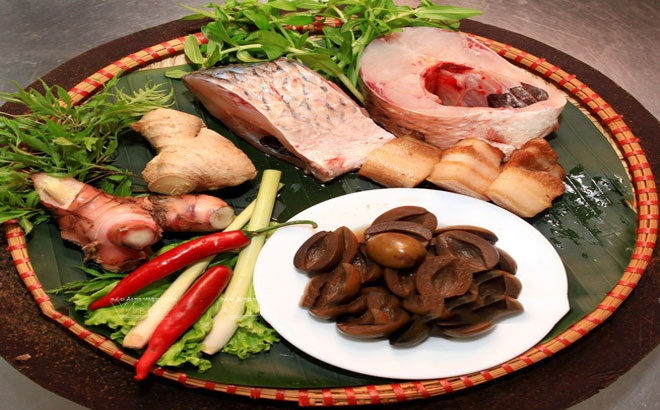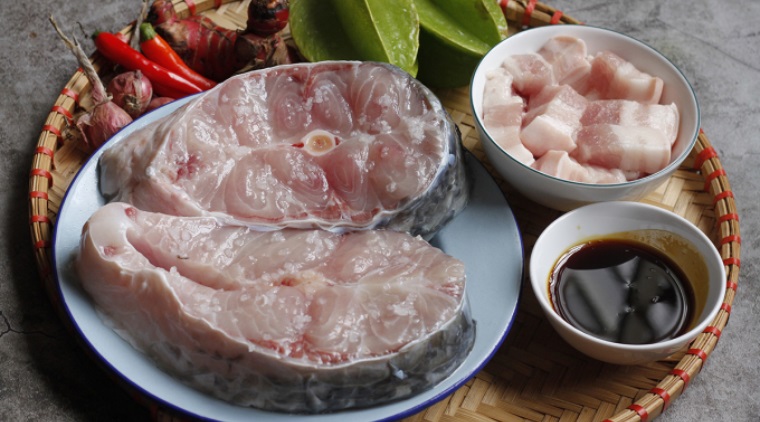Fish can be cooked into many delicious dishes, from steamed, fried, sautéed, braised to hotpot and porridge. However, the most familiar and popular dish among Vietnamese people is “cá kho” (braised fish). Each region has different accompanying ingredients and different ways of braising fish. But no matter how it is braised, the fish must have tender and firm flesh, not mushy, and the bones should be easily chewable. Let’s take a look at the following tips to make a perfect pot of braised fish.

Preparing the ingredients
– Clean the fish, remove the scales, fins, internal organs, and the black membrane inside the belly. Cut the fish into small pieces.
– To remove the fishy smell and sliminess, rub the fish with salt, especially the outer skin. Alternatively, use a mixture of white wine, ginger, fresh lime/vinegar, and rub it like using salt. They will clean the fish and prevent it from being fishy when braised. Rinse with clean or rice-washed water for the best result. Place the fish pieces in a bowl to drain.
– Clean the pork belly, slice it into square pieces like Chinese braised pork, clean the vegetables and spices, pound and chop them.
After cleaning the fish, pour boiling water over the fish to make it firm, the flesh firm, and prevent the fish from secreting too much amino acid so it won’t be fishy.
Marinating the fish
– Marinating the fish is an important step to make the braised fish flavorful and delicious. The marinade recipe is: 3 tablespoons of fish sauce, 2 teaspoons of MSG, 1 teaspoon of sugar, 1 teaspoon of oyster sauce, 1 teaspoon of soy sauce, 1 teaspoon of sesame oil, a tablespoon of cooking wine, a pinch of pepper, and sliced chili according to your taste. Note: The amount of seasoning listed is for 1kg of fish, if you make more, you need to increase the amount of seasoning accordingly.
– It is recommended to marinate the fish for about 2 hours for the fish to absorb the seasoning evenly, or at least marinate it for 30 minutes. If you have fresh tea leaves or used tea leaves that have been brewed once, you can add them to the marinade with the fish. Tea leaves will help remove the fishy smell and enhance the flavor of the braised fish.

To make the fish firm quickly: blanch the fish in boiling water and vinegar
Then line the bottom of the pot with pork fat or pork skin, tea leaves, and stack the fish and accompanying ingredients such as pickles, green bananas. Season with soy sauce, salt, and noodles according to your taste.
Pour boiling water into the pot absolutely don’t use cold water, only use boiling water to pour into the pot of fish. Place the pot of fish on the stove or cook in an electric rice cooker.
To make the fish bones tender, add a little vinegar or lime juice, it will help the fish flesh not be fishy and the bones will soften quickly. For a pot of fish about half a kilogram, add approximately 100ml of lime juice.

If you want the braised fish to have a distinctive aroma and spiciness, you can use green chili instead of red chili.
Tea leaves lining the bottom of the pot when braising fish helps remove the fishy smell and make the meat firm, giving a special flavor to the braised fish.
If you want the fish to have a sweet aroma, add a few slices of split sugarcane to the bottom of the pot. The aromatic aroma of burnt sugarcane will add a pleasant scent to the braised fish. Especially when braising with soy sauce or braising separately, fresh sugarcane is very fragrant.
If you want the braised fish to be fatty and aromatic, add pork fat to the bottom of the pot, it helps prevent the pot from burning and provides a sticky and fragrant substance for the braised fish.
Getting the perfect color for the braised fish
Use homemade caramel instead of store-bought caramel: Put sugar in a pot, but be careful not to let the sugar burn and turn black.

To enhance the color, you can add sesame oil or use Korean chili powder.
Note: To prevent the fish from breaking apart, absolutely do not flip or turn the fish pieces while braising. When the fish is cooked, open the lid and let it cool slightly before removing the fish. Handle gently and use chopsticks with a spoon to ensure that the fish pieces are intact when removed from the pot.






































